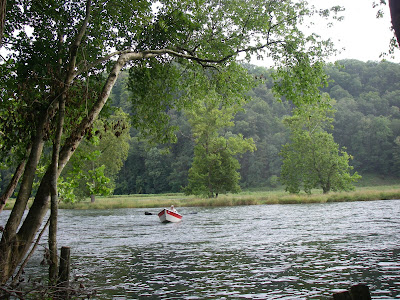
My backyard mountains have thrown off the gaudy attire of fall for the colors of faded flannel. Within a week they resembled rounded hunters in camo. Now winter's breath ices our necks and the hills look like eerie formations of emaciated Confederate soldiers, standing tall and straight still but rough around the edges. A little haggardness, I guess, sends the silent message that winter is a lilttle more than a week away.
Still, we catch trout. Not all the time, but mostly.
With just the smallest window of warm opportunity between the hours of 11 and 3, dry flies have been working well. Mostly, parachute Adams and tiny caddisflies.
Only one weekend was blown out by the icy wind. I joked at the flyshop that perhaps it was cold enough to rig up inside the Troutmobile while the heater blasted. You know, rig up, jump out, make a cast or two. Jump back in. Warm those fingertips. Jump out again.
Nah.
Another day and it was wind. Then wind and rain, heavy doses of both. The North Fork of the French Broad got rowdy and danced out of her banks. One motorist was swept into a field and had to be rescued.
I keep looking for little splashes of sun. If it warms the water some, it may warm up the trout appetites for dry flies.
They were popping pretty good last week. There is a little stretch about 400 feet in front of the cabin that few fish. It's just a surpreme bother to struggle through the rose thorns, so few bother.
The little girl across the street, along with her 4-year-old daughter, tried to clean my home waters out a month ago. They bagged a bunch. Kept 'em too.
Then, little momma tells me about the 31-inch brown some good ole boy caught at the waterfall last year.
That, friends, broke my heart. It was like General Lee once again had his sword stolen by some Yankee general.
More and more the trees lining the little creek took on the somber look of Army of Northern Virginia ghosts, standing blind sentry by precious water.
Still, we catch trout. Not all the time, but mostly.
With just the smallest window of warm opportunity between the hours of 11 and 3, dry flies have been working well. Mostly, parachute Adams and tiny caddisflies.
Only one weekend was blown out by the icy wind. I joked at the flyshop that perhaps it was cold enough to rig up inside the Troutmobile while the heater blasted. You know, rig up, jump out, make a cast or two. Jump back in. Warm those fingertips. Jump out again.
Nah.
Another day and it was wind. Then wind and rain, heavy doses of both. The North Fork of the French Broad got rowdy and danced out of her banks. One motorist was swept into a field and had to be rescued.
I keep looking for little splashes of sun. If it warms the water some, it may warm up the trout appetites for dry flies.
They were popping pretty good last week. There is a little stretch about 400 feet in front of the cabin that few fish. It's just a surpreme bother to struggle through the rose thorns, so few bother.
The little girl across the street, along with her 4-year-old daughter, tried to clean my home waters out a month ago. They bagged a bunch. Kept 'em too.
Then, little momma tells me about the 31-inch brown some good ole boy caught at the waterfall last year.
That, friends, broke my heart. It was like General Lee once again had his sword stolen by some Yankee general.
More and more the trees lining the little creek took on the somber look of Army of Northern Virginia ghosts, standing blind sentry by precious water.










.JPG)


















